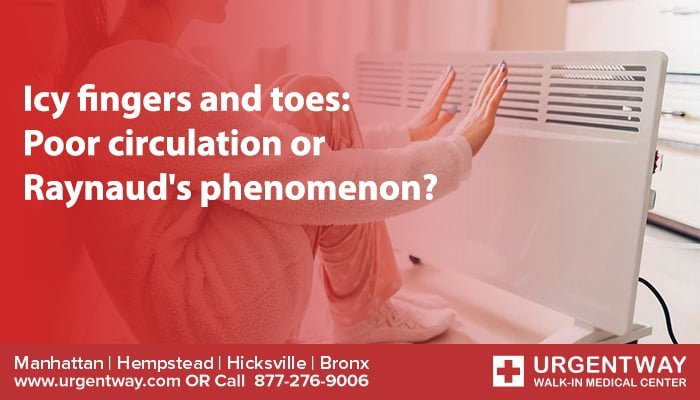If your fingers or toes turn pale and go numb when you are exposed to cold or stress, then you might have poor circulation. But, when even a slight change in environment can cause this condition then you might have Raynaud’s phenomenon. Ice fingers and toes are the common symptoms of Raynaud’s phenomenon or poor circulation. This phenomenon often occurs on its own but is sometimes linked with other situations such as scleroderma. This numbness and change in color of iced fingers and toes are due to the constriction of the blood vessels and short-term reduction in the blood supply. If you want to know about Raynaud’s phenomenon or poor blood circulation then this article is for you. Please continue your reading:
What are the symptoms of Raynaud’s phenomenon?
If your icy fingers and toes have numbness and coldness then there is poor circulation or Raynaud’s phenomenon. There are the following more common symptoms of poor circulation or Raynaud’s phenomenon:
- Prickly feeling
- Stinging pain
- Swelling
- Affected areas are not fingers and toes rather your lips, nose, ears and even your nipples can experience these symptoms.
This attack remains for only a few minutes but sometimes it can last even up to 2-3 hours.
What are the causes of Raynaud’s phenomenon or poor circulation?
There is no clear cause of poor circulation or Raynaud’s phenomenon but the following causes contribute to icy fingers and toes.
i. Reduction of blood supply
The change of color and pain in icy fingers and toes is due to a reduction in blood supply. The blood supply towards the fingers and toes is controlled by nerves of the blood vessels, so when someone experiences a cold temperature, the nerves reduce the blood supply. It is a natural mechanism of the body to prevent heat loss. People with Raynaud’s phenomenon respond too much and quickly to the cold temperature and shut off their blood supply than normal. As a result, the blood vessels reduce in size so less blood flows through them.
ii. Emotional changes
Emotional changes such as stress, depression, or anxiety may also trigger the attack of Raynaud’s phenomenon. Because when your body is in stressed then your “fight or flight response” activates which can restrict the nerves to shut down the blood supply.
iii. Use of vibrating machinery
Raynaud’s phenomenon may also occur as a result of using vibrating machinery such as pneumatic drills, hammer drills, hedge cutters, and other tools. When someone uses this equipment, a thrilling sensation triggers a sense of fear and causes the nerves to reduce the blood supply.
iv. Side effects of medicines
Raynaud’s phenomenon may also develop as a side effect of a few medicines such as beta blockers.
How can you be diagnosed with Raynaud’s phenomenon?
Your doctor will be able to make a diagnosis based on your symptoms and the results of your tests. Tests will be carried out to determine the type of primary or secondary forms of Raynaud’s phenomenon. There are the following tests your primary care doctor can carry out if they suspect you have Raynaud’s phenomenon.
- Blood tests
- X-ray
- Nailfold microscopy
- Cold stress test
How can you treat Raynaud’s phenomenon or poor circulation?
If you’re suffering from numbness or coldness of the icy fingers and toes there are a number of medications that may help:
- Nifedipine and Amlodipine treat Raynaud’s phenomenon by making the blood vessels wider.
- Losartan and ACE inhibitors relax the blood vessels and stop them from narrowing.
- Fluoxetine can improve circulation by treating depression and making you feel relaxed.
- Phosphodiesterase inhibitors improve the blood flow around the body.
What are the risk factors for Raynaud’s phenomenon?
Certain factors can increase your risk of developing the condition, such as:
- Connective tissue or autoimmune disease
- Chemical exposure
- Cigarette smoking
- Injury or trauma
- Repetitive actions, such as typing or the use of tools that vibrate like a jackhammer
- Side effects from certain medicines
How to manage the symptoms of poor circulation or Raynaud’s phenomenon?
symptoms of poor circulation or Raynaud’s phenomenon can be managed by:
- Avoiding exposure to cold
- Keeping warm with gloves, socks, a scarf, and a hat
- Stopping smoking
- Wearing finger guards over fingers with sores
- Avoiding trauma or vibrations to the hand
- Taking blood pressure medicines during the winter months to help reduce constriction of the blood vessels
Conclusion
Icy fingers and toes are caused as a response to the coolness. It is a natural mechanism to conserve the heat of the body. But, in some people, it happens frequently and immediately. This condition is also known as Raynaud’s phenomenon or poor circulation because in this the blood supply is reduced. You can simply manage the symptoms by taking measures at home or you can treat them with proper medicines.


